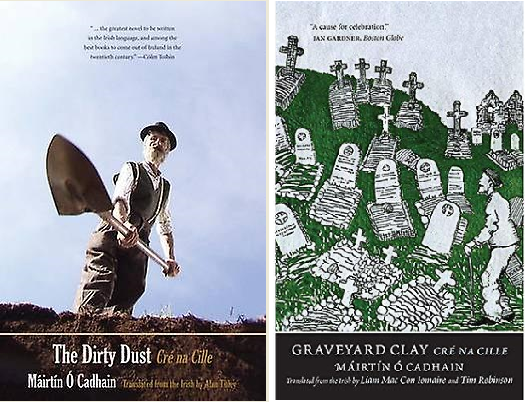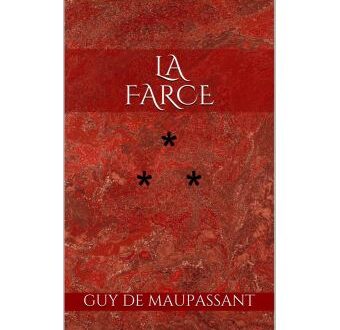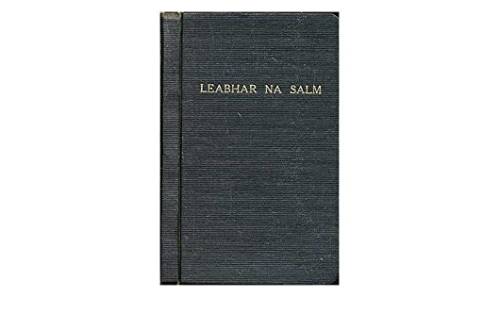
Graveyard Clay agus The Dirty Dust
Aistritheoirí: Alan Titley (The Dirty Dust) agus Liam Mac Con Iomaire and Tim Robinson (Graveyard Clay)
Foilsitheoir: Yale University Press (The Dirty Dust) agus Cló Iar-Chonnacht (Graveyard Clay)
Léirmheastóir: William Brennan
Foilsíodh an léirmheas seo cheana in The New Yorker an 17 Márta 2016
The Irish Novel That’s So Good People Were Scared to Translate It
In 1948, the Irish-language writer Máirtín Ó Cadhain received the kind of rejection letter a novelist might dream of getting. He had submitted his foul-mouthed first novel, “Cré na Cille” (“Churchyard Clay”), to his publisher, only to see it denied on the ground that it was too “Joycean.” This wasn’t meant as a compliment: it was the prudish publisher’s way of calling the book bawdy. A furious Ó Cadhain (pronounced O’Kine) took the novel elsewhere. In 1949, the Irish Press serialized it nationally over seven months, and the following year, the boutique publisher Sáirséal agus Dill released a bound version. The book became the talk of the Irish-speaking world. Young Irish speakers read it aloud to their illiterate grandparents—in Galway, according to one writer, college students passed the thrice-weekly Irish Press installments from hand to hand, and scrounged to buy the book when it appeared in stores.
Today, “Cré na Cille” is considered Joycean in a less euphemistic sense. A dust-jacket blurb from Colm Tóibín declares it “the greatest novel to be written in the Irish language, and among the best books to come out of Ireland in the twentieth century.” Scholars of Irish writing have hailed it as “a masterpiece” and “one of the most outstanding works in contemporary European literature.” “No superlatives can exaggerate its importance,” one early reviewer declared. Ó Cadhain, the critic Seán Ó Tuama wrote in 1972, produced “the most consciously-patterned and richly-textured prose that any Irishman has written in this century, except Beckett and Joyce.”
But for almost seventy years, Ó Cadhain’s greatest work remained inaccessible to nearly all Irish readers, because it was written in Irish Gaelic, a language vanishingly few of them speak, and it had never been translated into English. As if in overcorrection of this historical lapse, Yale University Press, together with the Irish-language publishing house Cló Iar-Chonnacht, has now put out not one but two English translations. For the first time, English speakers untutored in the Irish tongue can experience the exquisite vulgarity of Ó Cadhain’s book, and perhaps begin to understand the exalted standing it has had among Irish readers for decades.
All of the characters in “Cré na Cille” are dead. They are not ghosts or spirits but rather chattering, coffin-bound corpses, buried in a graveyard on Ireland’s west coast during the Second World War. They have left behind a world of rural hardship—a place where poor, Irish-speaking farmers eke out a living selling seaweed and periwinkles and coaxing potatoes out of rocky soil—only to find the bitter squabbles and petty pretensions of their villages continuing unabated in the ground. The book has no plot to speak of and unfolds entirely through dialogue. Dozens of voices make themselves known through a circuitous invocation of grievances and gossip: the Big Master, a haughty schoolteacher, declares his widow a “harlot” upon learning she quickly remarried after his death; Nora Johnny, a woman who once spent scandalous evenings with sailors in Galway nightclubs, insists she’s found “culture” in the grave; an insurance salesman brags about the villagers he swindled; an elderly woman insists she’d still be alive if she’d had the strength to lift herself out of the fire she fell into one day; someone repeatedly pledges allegiance to Hitler. Above all others rises the voice of Caitriona Paudeen, a viperous old woman who has long despised her (still-living) sister Nell, for marrying a man they both loved:
I thought I’d live for another couple of years, and I’d bury her before me, the cunt. She’s gone down a bit since her son got injured. She was going to the doctor for a good bit before that, of course. But there’s nothing wrong with her. Rheumatism. Sure, that wouldn’t kill her for years yet […] I nearly buried her. If I had lived just a tiny little bit more …
The inhabitants of the graveyard are hopelessly self-involved, but the book transcends their narrow purview. Their quotidian fixations and pious self-posturing achieve a magnificently improbable universality: look past the talk of seaweed farming and pilgrimages to sacred wells, and you start to sense that the corpses’ gripes and tall-tales—about drunken excursions, sticky-fingered neighbors, scheming paramours—are the same ones heard at bars and bus stops from Baltimore to Beijing.
At the same time, Ó Cadhain knew that writing in a language that few read limited his audience. “The writer in Irish, whether good, bad, or indifferent,” he declared in a 1969 lecture, “is writing for his own people and only for his own people.” Ó Cadhain’s “own people” very much resembled the characters of “Cré na Cille,” and he was fiercely dedicated to them. Born in 1906 to poor, Irish-speaking farmers on the country’s rugged west coast, Ó Cadhain escaped the hardscrabble life of many of his peers to become a grade-school teacher. An avowed socialist by his early twenties, he co-founded an activist organization that fought for the land and language rights of the country’s small, disenfranchised population of Irish speakers.
He also joined the I.R.A., an affiliation that caused him no end of trouble: in 1936, a priest who disagreed with his activism sacked him from his post as principal of a country school; from 1939 to 1944, the government held him in a prison camp for political dissidents. But he never relented, rousing crowds at protests even as his health failed him. In Ó Cadhain’s view, the threat to the language from government neglect and emigration was existential, and the outlook bleak. Toward the end of his life, an interviewer asked him where he thought the country was headed. “If we lose the Irish language, we lose our native literature,” he said, looking morose. “We’ll be finished as a people. The vision that every generation of Irish people had will be at an end.”
Sixty-six years is a long time to wait for an English translation of a book written and published a ferry-ride away from England. Why the delay? Rumors have long swirled that Ó Cadhain, angry at the social and cultural dominance of the English language, refused to permit a translation. But such a steadfast refusal seems unlikely: the original contract that Ó Cadhain signed addressed the question of translation, defining the payment he’d receive for one. It also included a provision, standard in the publisher’s contracts, imposing a two-year moratorium on translations after the original was published—and stipulating that a translation could be released only if the publisher felt satisfied its quality wouldn’t “diminish the author’s reputation.”
In fact, after the two-year period passed, Sáirséal agus Dill, Ó Cadhain’s publisher, took concrete steps toward putting out a translation. In the early nineteen-sixties, a contract was sent to a young woman who’d submitted a sample translation as part of an open contest. (A letter from the woman’s mother eventually came back: her daughter wouldn’t be able to finish the translation, she wrote, as she’d just entered a convent.) Sáirséal agus Dill next tried to entice the poet Thomas Kinsella to translate the book; though he was honored they’d considered him, Kinsella wrote in a 1963 letter, he was “sure it would be a very difficult job, especially since we’re talking about ‘Cré na Cille.’ It’s not an exaggeration to say it would take years.” Shortly after, a man whom Ó Cadhain had met in prison agreed to take up the task, with the help of a native Irish speaker. When he finally submitted his manuscript, in 1967, the publishers were shocked: the characters were speaking, inexplicably, in Dublin dialect. They rejected him judiciously. “While we expect to publish it sometime, if [the company] survives,” one of the editors told him, “we cannot currently offer any date.”
“Cré na Cille” was also a victim of its own repute. The Irish-language publishing house Cló Iar-Chonnacht currently holds the copyright, having acquired it in 2009. Micheál Ó Conghaile, the house’s founder, told me that the previous holder, Caoimhín Ó Marcaigh, who acquired the copyright from Sáirséal agus Dill in 1981, avoided translating the book into English because “he wanted to be maybe two hundred per cent sure that the translation would really be perfect.” Ó Marcaigh died in 2014, but his son Fiachra recently confirmed as much to me in an e-mail: Ó Marcaigh, he wrote, “was conscious of the great difficulty that there would be in translating the work and doing it justice in another language.” He was also aware of “the pressures … involved in authorising a translation of a work of such standing.” If the book botched its first entry into English, its place in the canon could be damaged. Ó Marcaigh’s refusal to translate the book was the final word for almost three decades, until Cló Iar-Chonnacht bought his company in 2009—in part, just to gain control of the “Cré na Cille” copyright, Ó Conghaile said.
There are now, suddenly, two versions of the novel in English. The first one, published under the title “The Dirty Dust,” appeared last March; the second one, more literally titled “Graveyard Clay,” is out this month. These two translations—different from one another in ways large and small—lay to rest the fable of the “perfect” translation.
In the mid-sixties, Liam Mac Con Iomaire, the seventy-eight-year-old co-translator of “Graveyard Clay,” used to hang out in Ó Cadhain’s pub of choice, in Dublin. He and his friends would drink beers and secretly gawp at the writer from a distance. “I was in awe of him,” Mac Con Iomaire told me. “He was considered a god. He was considered the best writer in English or in Irish.” (Mac Con Iomaire eventually got to know Ó Cadhain, driving the writer home from the pub one night when he was drunk.) The book’s rich, challenging language and its lofty position in the Irish canon, Mac Con Iomaire said, helped scare off potential translators for decades. Nobody wanted to be the person who fumbled the translation of the language’s greatest novel. “It would be like translating ‘Ulysses’ into Irish,” Mac Con Iomaire said. “You daren’t put a foot wrong if you are translating Máirtín Ó Cadhain.”
In the early two-thousands, Mac Con Iomaire and his co-translator, the English cartographer Tim Robinson, read an article in the Irish Times pleading for someone to translate the novel. They decided to dare it. Mac Con Iomaire admitted to me that he’d felt “afraid, to a degree,” because he knew that expectations were high and that the book’s language presented a challenge. But he cast the fear aside: in his introduction to “Graveyard Clay” he disclaims the “sense of linguistic piety or cultural decorum” that for so long kept potential translators away.
Alan Titley, the translator of the version published last year, felt comparatively unencumbered—though his story is not unlike that of Mac Con Iomaire. In his college days, Titley also used to gawp at Ó Cadhain in the Dublin pub. (He told me that he once caught a rosy-cheeked Ó Cadhain hiding a bottle of whiskey in a grand piano, apparently for safekeeping, at a social gathering.) Titley is a scholar of Irish-language literature and a celebrated novelist in the language; he knew the book’s reputation well. But he was unafraid. “I don’t agonize,” he said.
“The Dirty Dust” is a feat of translation: vigorous and fun, each line rendered with idiomatic aplomb, not a shadow of the Irish grammar remaining. Titley, like Ó Cadhain, is an accomplished wordplayer; he never struggles for the obscure synonym. But this legibility comes at a price: Titley seems not have been able to resist his own (very distinctive) voice, and the results can feel overbearing at times. Ó Cadhain conjured many a neologism for “Cré na Cille,” but certain word choices in “The Dirty Dust” read as beguiling anachronisms. (“Holy fuckaroni!” Caitriona Paudeen, a rural woman born in the nineteenth century and dead before the end of the Second World War, shrieks at one point.) Readers might justly wonder how much of “The Dirty Dust” is Ó Cadhain and how much is Titley.
Mac Con Iomaire and Robinson followed a single maxim in translating the text: “Be faithful to Ó Cadhain.” Not surprisingly, “Graveyard Clay” feels more restrained than “The Dirty Dust,” and not simply because Titley reached for flashier imprecations. (Whereas “The Dirty Dust” is a minefield strewn with the words “cunt” and “fuck,” the fields of “Graveyard Clay” are littered with gentler explosives: “bitch,” “damn,” and the like.) The corpses’ dialogue in “Graveyard Clay” is rendered in a sort of toned-down Hiberno-English, a defensible decision that nevertheless gives the text an occasionally awkward flavor. Take the string of curses that one character heaps upon another. In “Graveyard Clay,” prepositions—a prominent feature of Gaelic grammar—pile up:
Blinding without light on him, and the blinding of Ossian on top of that! May the itch of the Prophet’s women consume him! Swelling of knees on him! The red tracks of a tail-band on him! The sting of fleas on him! …
In “The Dirty Dust,” Titley drops the prepositions—and the effect, to English ears, is a more natural sound:
May he be blinded without a glimmer and be gouged like Oisín after that! The Itch of the Women of the Prophet! His knees explode! His rump redden with rubenescence! Be lanced by lice! …
Still, awkward passages are rare in “Graveyard Clay”; the translation, on the whole, is remarkably elegant. And the two translations together are a helpful reminder that having multiple interpretations of a text serves readers better than one definitive—or “perfect”—translation ever could. “Graveyard Clay,” outfitted with footnotes and a bibliography, is clearly meant for the classroom and for academic citation, while the proper place for “The Dirty Dust” is on a bedside table, with a bookmark slowly advancing through it, night by night. Both books belong, as the novel itself always has, well above ground.




